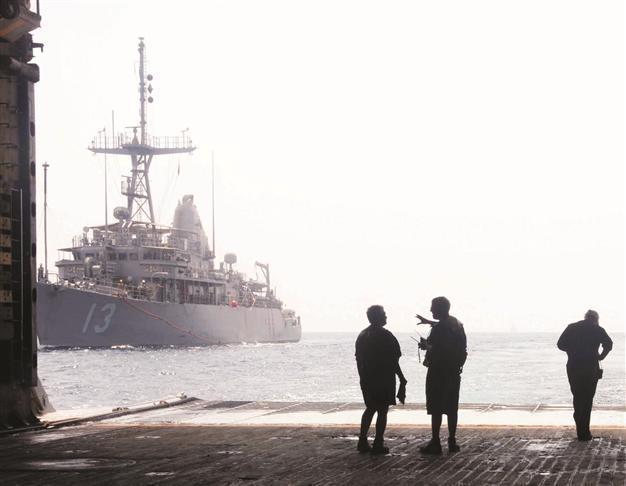US, allies start ‘largest’ naval drill near Hormuz
DUBAI

Military Sealift Command civilian mariners aboard Afloat Forward Staging Base USS Ponce observe an astern replenishment-at-sea with mine countermeasures ship USS Dextrous in this photo taken from the official website of the US Navy.
The United States and its allies have launched the biggest naval exercises ever in the Middle East with battleships, aircraft carriers, minesweepers and submarines in the Persian Gulf amid the row over Iran’s controversial nuclear program.The exercises are taking place near the Strait of Hormuz, which Iran has threatened to close over the economic sanctions imposed over its nuclear program. U.S. Navy officials insist that the anti-mine exercise is not about any specific country or a response to Iranian threats to shut the narrow Strait of Hormuz at the mouth of the gulf, the route for one-fifth of the world’s oil. Iran has said its forces will be monitoring the maneuvers. “We are very sensitive about security in the highly strategic Persian Gulf and we are watching closely,” Iranian Foreign Ministry spokesman Ramin Mehmanparast said.
“The exercises are based on a hypothetical threat to mine the international strategic waterways of the Middle East, including the Red Sea, the Gulf of Aden, the Gulf of Oman, and the Persian Gulf,” the U.S. Central Command said in July.
Three US aircraft carriers
Warships from more than 25 countries, including the U.S., Britain, France, Saudi Arabia and the United Arab Emirates are taking part in the annual 12-day exercise to prepare for any pre-emptive or retaliatory action by Iran, according to British newspaper Daily Telegraph. The report said the navies will practice tactics regarding how to breach an Iranian blockade of the strait and the force will also undertake counter-mining drills.
The multi-national naval force in the gulf includes three U.S. Nimitz-class carrier groups, each of which has more aircraft than the entire complement of the Iranian air force. The carriers are supported by at least 12 battleships, including ballistic missile cruisers, destroyers and assault ships carrying thousands of U.S. Marines and special forces.
The British component consists of four British minesweepers and the Royal Fleet Auxiliary Cardigan Bay, a logistics vessel. HMS Diamond, a brand-new Type 45 destroyer and one of the most powerful ships in the British fleet, will also be operating in the region. In addition, commanders will also simulate destroying Iranian combat jets, ships and coastal missile batteries.In addition to the Persian Gulf, anti-mine practice is planned for the Gulf of Oman and the Gulf of Aden, the gateway to the Red Sea that has been a focus of international efforts to fight Somali pirates.
The head of Iran’s powerful Revolutionary Guards warned of retaliation against the Strait of Hormuz, U.S. bases in the Middle East and Israel if his country was to be attacked. General Mohammad Ali Jafari said the Strait of Hormuz would be a legitimate target for Iran should it be attacked.
“This is a declared policy by Iran that if war occurs in the region and the Islamic republic is involved, it is natural that the Strait of Hormuz as well as the energy (market) will face difficulties,” Agence France-Presse quoted him as saying.
Jafari suggested that U.S. military bases would also be fair game for retaliation by Iranian missiles or proxy forces. “The U.S. has many vulnerabilities around Iran, and its bases are within the range of the Guards’ missiles. We have other capabilities as well, particularly when it comes to the support of Muslims for the Islamic republic,” he said.
















